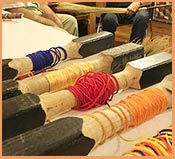Joyce Kilmer Memorial Forest
Discover the towering trees and carpets of wildflowers in this remnant of the original Appalachian forest.
This forest is one of the Nation's most impressive remnants of old-growth forest. The forest contains magnificent examples of more than 100 tree species, many over 400-years-old, and some more than 20 feet in circumference and 100 feet tall. This 3,800-acre forest was set aside in 1936 as a memorial to the author of the poem "Trees" Joyce Kilmer, who was killed in action in France during World War I. This forest, part of the Joyce Kilmer-Slick Rock Wilderness, is maintained in its primitive state. The only way to see this forest is on foot. A 2-mile trail leads to the Joyce Kilmer Memorial and loops through giant trees. A restroom and picnic tables are located at the trail-head.
Journey into a magnificent forest . . .
Read our feature story Giants of the Forest
The Experience
A walk through Joyce Kilmer Memorial Forest is a journey back in time through a magnificent forest with towering trees as old as 450 years. Some enormous tulip-poplars are more than 20 feet in circumference and stand 100 feet tall. The floor is carpeted with wildflowers, ferns, and moss-covered logs from fallen giants. The only way to see the impressive memorial forest is on foot. The figure-eight Joyce Kilmer National Recreation Trail covers 2 miles and has two loops: the 1.25-mile lower loop passes the Joyce Kilmer Memorial plaque, and the upper 0.75-mile loop swings through Poplar Cove - a grove of the forest's largest trees. The trail-head. parking area has a flush toilet and picnic tables. No camping or overnight parking is allowed.
A Special Forest
The Joyce Kilmer Memorial Forest, part of the Nantahala National Forest, is a great example of a cove hardwood forest - a forest characterized by rich soils, abundant moisture, and a variety of plants. In 1935, the regional forester wrote that the forest was one of the "very few remaining tracts of virgin hardwood in the Appalachians (and) we ought to buy it to preserve preserve some of the finest original growth in the Appalachians." The Forest Service bought 13,055 acres in 1936 for the lofty sum of $28 per acre (at a time when most land was going for $3 to $4 per acre). While most of the surrounding land was logged, the area around Little Santeetlah Creek was spared - protected by the recognition of its uniqueness and the drastic drop of lumber prices after the "crash of 1929."
Designated Wilderness
In 1975, Congress designated this land around Little Santeetlah and Slickrock Creeks as the Joyce Kilmer-Slickrock Wilderness. The designation included the memorial forest. Presently, the wilderness totals 17,394 acres. North Carolina contains 13,562 acres and Tennessee contains 3,832 acres. Like other wildernesses, Joyce Kilmer-Slickrock is managed to protect naturalness and solitude. No motorized or mechanical vehicles or equipment, such as cars, chainsaws or bicycles, are allowed within the wilderness. Trails are maintained to the most primitive standards, with few, if any, signs or blazes.
A Living Memorial
Veterans of Foreign Wars asked the government to set aside a fitting stand of trees to serve as a living memorial to Joyce Kilmer, who was killed in action during World War I. Although Kilmer was both a soldier and poet, he is most remembered for his poetry about common, beautiful things in nature. Kilmer's best-known poem is "Trees" which is printed to the right.
TREES
I think that I shall never see
A poem lovely as a tree.
A tree whose hungry mouth is prest
Against the earth's sweet flowing breast;
A tree that looks at God all day,
And lifts her leafy arms to pray;
A tree that may in summer wear
A nest of robins in her hair;
Upon whose bosom snow has lain;
Who intimately lives with rain.
Poems are made by fools like me,
But only God can make a tree.
- Joyce Kilmer
Other Recreation
Two campgrounds are located about 0.5 mile from the memorial forest. Offering 18 sites, Horse Cove Campground is open from April to October. For groups, the Rattler Ford Group Campground is open April through October and offers four sites. Each site accommodates 25. To make required reservations, call the Cheoah District at 828-479-6431. Hunting and fishing are allowed in the forest and surrounding wilderness. This area is popular for bear and boar hunting from mid-October until January 1.
Be Alert it the Forest
The huge trees are very old; some are dying, which creates the potential for falling limbs and trees. Because the forest is in a designated wilderness, dead trees are not removed. Please follow these tips for your safety and the health of the forest:
-
Stay out of the memorial forest on windy days or after a snowfall or ice storm when branches and trees are more likely to fall.
-
Be alert! Glance overhead frequently and don't linger under dead and dying trees.
-
Stay on the trail to avoid trampling plants and preventing damage to tree roots.
-
Leave all plants for others to enjoy. No plants, living or dead, may be cut or removed.
More information about Joyce Kilmer Memorial Forest click here....
Directions
From Asheville: Take I-40W to Exit 27. Exit right onto U.S. 19/74 toward Waynesville. Go about 47 miles, and bear right on NC 28N. Go 5 miles, and turn left on NC 143 to Robbinsville.
From Robbinsville: Take NC 143W. After about 12 miles, turn right on Joyce Kilmer Road (SR1134). Go 2 miles and turn left to memorial forest.
for more information:
Cheoah Ranger District
1133 Massey Branch Road
Robbinsville, NC 28771
Phone: 828-479-6431
mailroom_r8_nantahala@fs.fed.us
National Forest Service...Leave no Trace Policy
Printable
State • Town • City • County • Guide
If you would like to know what towns are in which county,
use these printable pages to find out.
Western North Carolina Mountain • Printable City and Town Guide

The Blue Ridge Highlander logo, all photography, design, graphics, artwork, writing, digital images, etc are the Copyright © of C. Wayne Dukes and Sherry Bell Dukes, 1996 to current day, except where otherwise stated. All rights reserved, reproduction, downloading, and/or duplication of any sort is strictly prohibited, all violations will be prosecuted. Legal Policy. If you have any questions, or comments, regarding this site, e-mail the Highlander.
 Menu
Menu





